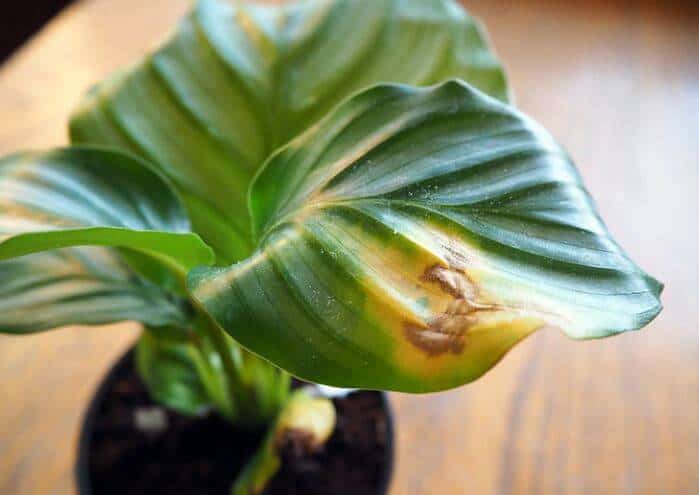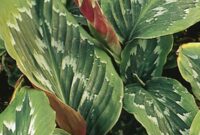1: Understanding the Causes of Yellowing Leaves
When you’re a plant enthusiast, there’s nothing quite as disheartening as seeing your beloved prayer plant’s leaves turn yellow.
These vibrant, variegated leaves are one of the reasons why Maranta leuconeura, commonly known as the prayer plant, is a favorite among indoor gardeners.
However, when those leaves start losing their luster and turning yellow, it’s a signal that something isn’t quite right.
Common Causes of Yellowing Leaves
Lighting Issues
One of the primary factors contributing to yellowing prayer plant leaves is inadequate or excessive lighting.
Prayer plants are native to the understory of tropical forests, which means they thrive in dappled or indirect sunlight.
If your plant is exposed to too much direct sunlight, the leaves can scorch and turn yellow. On the flip side, insufficient light can lead to poor photosynthesis, causing leaves to lose their green pigment.
To remedy this, it’s crucial to find the right balance of light conditions for your prayer plant. If it’s receiving too much direct sunlight, consider moving it to a spot with gentler, filtered light.
Conversely, if it’s in a dimly lit corner, try relocating it to an area with brighter but indirect light. Observing your plant’s response will help you determine the ideal lighting conditions.
Watering Problems
Watering practices are another key factor in the health of your prayer plant’s leaves. Overwatering and underwatering can both result in yellowing foliage.
When you overwater, the roots become waterlogged, leading to root rot and reduced nutrient uptake, which can manifest as yellow leaves.
Conversely, underwatering can cause stress to the plant, leading to leaf discoloration.
To maintain vibrant leaves, it’s essential to establish a proper watering routine.
This typically involves allowing the top inch or two of the soil to dry out before watering. Always use well-draining soil and pots with drainage holes to prevent waterlogged roots.
Humidity Concerns
The humidity levels in your home can significantly impact the health of your prayer plant.
These plants thrive in environments with high humidity, mimicking their tropical origins.
When humidity levels are too low, the plant may struggle to transpire effectively, leading to dry, yellowing leaves.
Maintaining appropriate humidity is crucial for your prayer plant’s well-being.
You can increase humidity by misting the leaves, using a humidity tray, or placing a room humidifier nearby.
Consistently providing the right humidity levels will help your plant’s leaves stay green and lush.
Nutrient Deficiencies
Leaf color is heavily influenced by the presence of essential nutrients. If your prayer plant lacks vital nutrients, it can result in yellowing leaves.
Common nutrient deficiencies include nitrogen, iron, and magnesium.
Each of these deficiencies can manifest differently, but they all impact the plant’s ability to produce chlorophyll, which is essential for the green coloration of leaves.
Conclusion
Understanding the causes behind your prayer plant’s yellowing leaves is the first step towards nursing it back to vibrancy.
2: Solutions for Yellowing Prayer Plant Leaves
In the previous section, we delved into the common causes of yellowing leaves on your prayer plant, shedding light on factors like lighting, watering, humidity, and nutrient deficiencies.
Now, armed with a better understanding of these underlying issues, it’s time to take action and restore your prayer plant’s health and vibrant foliage.
Remember, the key to success lies in selecting the right solution based on the specific cause of leaf discoloration.
Addressing Lighting Issues
If inadequate or excessive lighting is the culprit behind your prayer plant’s yellowing leaves, don’t worry; there are steps you can take to rectify the situation:
- Adjusting Lighting Conditions:
- If your plant is exposed to too much direct sunlight, consider moving it to a spot with gentler, filtered light.
- Conversely, if your prayer plant is struggling in a dimly lit corner, relocate it to an area with brighter but indirect light.
- Monitor and Observe:
- Keep a close eye on your plant’s response to the adjusted lighting conditions. You’ll want to ensure it’s thriving in its new environment.
Improving Watering Practices
Proper watering is essential for your prayer plant’s well-being. Here’s how to ensure you’re providing the right moisture levels:
- Establish a Watering Schedule:
- Create a consistent watering routine that allows the top inch or two of the soil to dry out before watering again.
- Check Soil Moisture Effectively:
- Use your finger or a moisture meter to gauge soil moisture levels accurately. Avoid watering if the soil still feels damp.
Managing Humidity Levels
Maintaining the correct humidity levels is vital for your prayer plant’s overall health:
- Increase or Decrease Humidity as Needed:
- Invest in a humidity tray or room humidifier to raise humidity levels if they are too low. Place it near your plant.
- If your home is excessively humid, consider using a dehumidifier to reduce moisture levels in the air.
Addressing Nutrient Deficiencies
To address nutrient deficiencies, you need to identify them correctly and apply the right solutions:
- Identify Nutrient Deficiencies:
- Carefully examine your prayer plant’s leaves for signs of nutrient deficiencies, such as yellowing with specific patterns.
- Recommend Appropriate Fertilizers:
- Depending on the deficiency, select a well-balanced fertilizer that contains the lacking nutrients. For instance, a fertilizer high in nitrogen can address nitrogen deficiency.
- Application Methods:
- Follow the recommended application methods on the fertilizer label. Be cautious not to over-fertilize, as this can lead to other problems.
Conclusion
In this section, we’ve explored practical solutions for addressing the common causes of yellowing leaves on your prayer plant.
Remember, the key to success is identifying the specific issue affecting your plant and applying the appropriate remedy.
Whether it’s adjusting lighting conditions, improving your watering practices, managing humidity levels, or addressing nutrient deficiencies, taking prompt action is essential to help your prayer plant regain its lush, green vitality.
Your efforts will be rewarded with a healthy and vibrant prayer plant that brings beauty to your indoor garden.
3: Preventive Care for Healthy Prayer Plant Leaves
As any plant enthusiast knows, keeping your prayer plant’s leaves vibrant and green is a rewarding endeavor.
But rather than just reacting to problems as they arise, taking a proactive approach through preventive care is the key to long-term success.
Creating a Maintenance Routine
To maintain the health of your prayer plant and its beautiful leaves, it’s crucial to establish a regular care routine. Here’s how you can do it:
- Cleaning:
- Regularly wipe the leaves with a damp cloth or sponge to remove dust and keep them free from debris. Clean leaves can better photosynthesize and remain green.
- Pruning:
- Trim yellowing or damaged leaves as soon as you notice them. This not only improves the plant’s appearance but also redirects nutrients to healthier growth.
- Monitoring:
- Keep a close eye on your prayer plant for any signs of distress. Early detection of issues allows for quicker intervention and resolution.
Choosing the Right Pot and Soil
The choice of pot and soil is more important than you might think. Here’s why it matters:
- Pot Size:
- Ensure your prayer plant is in an appropriately sized pot. A pot that is too large can retain excess moisture, while one that is too small can lead to root-bound plants. Choose a pot that provides room for growth without being excessively spacious.
- Soil Type:
- Use well-draining potting soil that allows excess water to escape, preventing root rot. Many garden centers offer potting mixes specifically designed for tropical plants like the prayer plant.
Pest Prevention and Control
Pests can quickly turn your prayer plant’s leaves yellow. Here’s how to prevent and manage infestations:
- Prevention:
- Keep your plant in a clean environment.
- Isolate new plants for a period to prevent potential pest introduction.
- Regularly inspect your prayer plant for signs of pests, such as spider mites or aphids.
- Identification:
- Learn to identify common prayer plant pests. Early detection is crucial.
- If you spot pests, isolate the affected plant to prevent them from spreading to others.
- Treatment:
- For minor infestations, consider using natural remedies like neem oil or a gentle soap solution.
- In severe cases, consult a professional for effective pest control.
Conclusion
Preventive care is the foundation of maintaining healthy, green leaves on your prayer plant.
By creating a maintenance routine, choosing the right pot and soil, and implementing pest prevention strategies, you can ensure that your prayer plant continues to thrive.
The benefits of preventive care extend beyond aesthetics—it also contributes to your plant’s overall well-being and longevity.
So, embrace these practices and make them a part of your regular routine to enjoy the beauty of your prayer plant for years to come.
4: Troubleshooting Yellowing Leaves: When to Seek Professional Help
In the world of plant care, it’s common to encounter issues that can be resolved with a little TLC and DIY know-how.
However, there are times when the health of your prayer plant, as indicated by its yellowing leaves, may be more complex than meets the eye.
Identifying Severe Issues
While many cases of yellowing leaves can be attributed to common causes like lighting, watering, humidity, or nutrient deficiencies, there are signs that indicate a more severe problem:
- Widespread Yellowing:
- If a significant portion of your prayer plant’s leaves turns yellow rapidly, it could indicate a systemic issue that requires immediate attention.
- Leaf Damage Patterns:
- Unusual leaf damage patterns, such as irregular holes or severe discoloration, might be indicative of a more complex problem.
- Stunted Growth:
- If your prayer plant’s overall growth is stunted, it may point to an underlying issue with its root system or other vital functions.
Early detection of such severe issues is essential, as it can significantly increase the chances of effective treatment and recovery.
When to Consult a Plant Expert
So, when should you consider seeking the expertise of a botanist or horticulturist?
- Recurring or Unresolved Problems:
- If you’ve tried DIY solutions, and the yellowing of your prayer plant’s leaves persists or worsens, it’s time to consult an expert.
- Complex Symptoms:
- When you observe complex symptoms or patterns of damage that you can’t identify or treat effectively on your own, it’s wise to reach out to a professional.
- Rare or Rarely Cultivated Species:
- If you’re caring for a rare or less common prayer plant species, consulting an expert who specializes in that particular plant can be invaluable.
Finding plant experts or local resources can be as simple as reaching out to your local botanical gardens, plant nurseries, or university extension programs.
They can often provide recommendations or connect you with professionals who can assist you.
What to Expect from Professional Help
During a consultation with a plant expert, here’s what you can anticipate:
- Diagnosis:
- The expert will assess your prayer plant’s health and diagnose the problem.
- Treatment Plan:
- They will develop a customized treatment plan tailored to your plant’s specific needs.
- Interventions:
- Depending on the diagnosis, treatments may include specialized fertilizers, pesticides, or other interventions.
Seeking professional help is not a sign of failure but rather a commitment to the well-being of your prayer plant.
Conclusion
In conclusion, while DIY solutions can often resolve common issues with your prayer plant, there are times when professional help is the wisest course of action.
Early identification of severe issues, knowing when to consult a plant expert, and understanding what to expect during a professional consultation are crucial steps in ensuring your prayer plant’s health and longevity.
Don’t hesitate to reach out for assistance if you suspect a severe problem with your prayer plant.
Your proactive approach could make all the difference in preserving those vibrant green leaves you cherish.
.
.
.
source image : https://afriendlygardener.com/houseplants/problems-how-to-fix/help-my-prayer-plant-leaves-are-turning-yellow/



